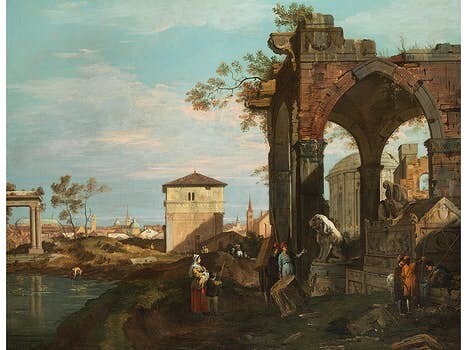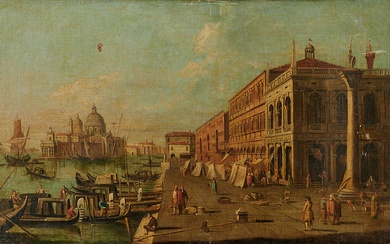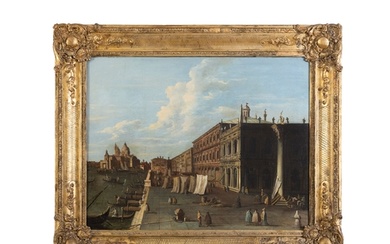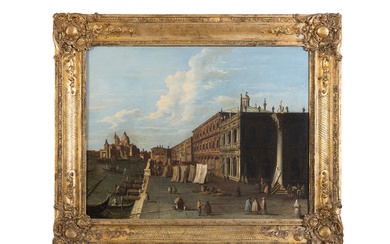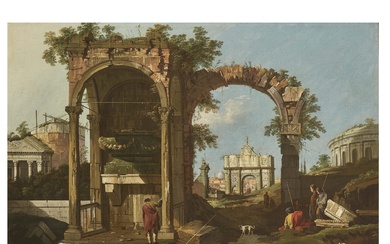Giovanni Antonio Canal, genannt „Canaletto“‘, 1697 – 1768 Venedig, RUINENCAPRICCIO MIT RÖMISCH-ANTIKEN FIGUREN UND DENKMÄLERN SOWIE DER VEDUTE DER STADT PADUA
Öl auf Leinwand.
70 x 90,7 cm.
In bronziertem Rahmen.
Further information on this artwork
Beigegeben in Kopie ein Gutachten von Dario Succi, 5. Juni 1995. Ebenfalls in Kopie ein Bestätigungsschreiben von Prof. Ugo Ruggeri, Venedig, sowie von F. Pedrocco, 13. März 2002, und Prof. Giuseppe Maria Pilo, 12. März 2000.
Vor dem Betrachter breitet sich ein prächtiger Ausblick über die Stadt Padua aus mit einem Ruinencapriccio im Vordergrund und der Porta Ponte Corvo im Zentrum des Gemäldes mit dem links im Vordergrund sichtbaren Canale Piovego und darüber der Palazzo della Ragione mit seinen wundervollen Arkadengängen sowie die Kuppel und der Campanile der Santa Giustina. Rechts im Vordergrund jedoch ein architektonisches Versatzstück mit welchem Canaletto sein in Lichtregie typisches Werk von rechts her einführt: eine gotische Bogenhalle mit gotischem Aufbau. Die ruinösen Arkaden sind typisch für Canaletto und können als Hauptaugenmerk im Zentrum des Geschehens stehen, wie in dem Gemälde von 1756, welches sich im Museo Poldi Pezzoli in Mailand befindet, oder bei uns eine einleitende Funktion haben, wenn das Hauptaugenmerk auf dem Mittel- und Hintergrund liegen soll. Der geschichtliche Aspekt, den die Ruinen vermitteln sollen und welcher historischen Skulpturen – wie hier der Löwe oder der rechts am Bildrand befindliche Sarkophag – innewohnt, wird nachdrücklich durch die Staffagefiguren vermittelt, welche zwar einerseits ihren Alltagsgewohnheiten nachgehen, andererseits aber (vielleicht Reisende) den historischen Monumenten Aufmerksamkeit schenken. Häufig sehen wir den müden Blick von Staffagefiguren, wie bei der sitzenden Figur ganz rechts am Rand. Dario Succi schlägt für unser Werk eine Datierung von 1742-1745 vor, während alle anderen von einer reiferen Schaffensperiode um 1756 ausgehen, also nach seiner Rückkehr nach Venedig von seiner ausgedehnten London Reise. Von diesem natürlich sehr beliebten Thema mit der schönen Ansicht Paduas gibt es mehrere Fassungen, wobei die ursprüngliche Fassung bis heute noch nicht sicher bestimmt ist. Am nächsten kommt unserem Gemälde die Version in der Kunsthalle Hamburg (Constable-Links, Bd. I, Nr. 496, Bd. II, Nr. 496). Dario Succi bescheinigt dem Gemälde „una qualitá pittorica eccelente, come dimostrano le bellissime „macchiette“ (figure) toccate con maestria e connotate dalla tipica disinvolta e fluente grafia canalettiana“.
Provenienz:
Privatsammlung.
Literatur:
Vittorio Moschini (Hrsg.), Canaletto, Athenäum, Bonn 1955.
W. G. Constable und J. G. Links, Canaletto. Giovanni Antonio Canal 1697-1798, Oxford 1989, Bd. I, N. 496, und Bd. II, Nr. 496.
Vergleiche:
Ein gleiches Bild aus Canalettos Hand und seiner Werkstatt befindet sich in der Galleria dell‘Accademia in Venedig und zeigt nur wenige Unterschiede, etwa in einer etwas kühleren Farbigkeit.
Eine ähnliche Darstellung Canalettos war ausgestellt in: Canaletto e i vedutisti. L‘incanto dell‘acqua, Palazzo Penotti Ubertini, 2011. (1240591) (13)
Giovanni Antonio Canal,
also known as “Canaletto”,
1697 – 1768 Venice
RUIN CAPRICCIO WITH ANCIENT ROMAN FIGURES AND MONUMENTS AS WELL AS
VEDUTA OF PADUA Oil on canvas.
70 x 90.7 cm.
In burnished frame.
Accompanied by a copy of the expert’s report by Dario Succi, 5 June 1995 and a copy of the confirmation letter by Professor Ugo Ruggeri, Venice, by F. Pedrocco, 13 March 2002, and Professor Giuseppe Maria Pilo, 12 March 2000.
Magnificent view of Padua city with a ruin capriccio in the foreground and the Porta Pontecorvo at centre, the Piovego Canal in the foreground to the left surmounted by the Ragione Palace with its beautiful arcades and cupola and the campanile of Basilica di Santa Giustina. Several versions of this highly popular subject with the beautiful vista of Padua are known, however, to date it is not entirely clear, which of them is the original version. A version held at Kunsthalle Hamburg (Constable-Links, vol. I, no. 496, vol. II, no. 496) appears to be closest to the painting on offer for sale in this lot. Dario Succi describes the painting on offer for sale here as “una qualitá pittorica eccelente, come dimostrano le bellissime ‘macchiette’ (figure) toccate con maestria e connotate dalla tipica disinvolta e fluente grafia canalettiana.”
Provenance:
Private collection.
Literature:
V. Moschini (ed.), Canaletto, Athenäum, Bonn 1955.
W. G. Constable and J. G. Links, Canaletto. Giovanni Antonio Canal 1697 - 1798, Oxford 1989, vol. I, N. 496, and vol. II, no. 496.
Examples of comparison:
The same depiction by Canaletto and his workshop is held at Galleria dell’Accademia in Venice with only few differences, for example a slightly cooler colour palette.
A similar depiction by him was exhibited at: Canaletto e i vedutisti. L’incanto dell’acqua, Palazzo Penotti Ubertini, 2011.
This object has been individually compared to the information in the Art Loss Register data bank and is not registered there as stolen or missing.
View it on
Estimate
Time, Location
Auction House
Öl auf Leinwand.
70 x 90,7 cm.
In bronziertem Rahmen.
Further information on this artwork
Beigegeben in Kopie ein Gutachten von Dario Succi, 5. Juni 1995. Ebenfalls in Kopie ein Bestätigungsschreiben von Prof. Ugo Ruggeri, Venedig, sowie von F. Pedrocco, 13. März 2002, und Prof. Giuseppe Maria Pilo, 12. März 2000.
Vor dem Betrachter breitet sich ein prächtiger Ausblick über die Stadt Padua aus mit einem Ruinencapriccio im Vordergrund und der Porta Ponte Corvo im Zentrum des Gemäldes mit dem links im Vordergrund sichtbaren Canale Piovego und darüber der Palazzo della Ragione mit seinen wundervollen Arkadengängen sowie die Kuppel und der Campanile der Santa Giustina. Rechts im Vordergrund jedoch ein architektonisches Versatzstück mit welchem Canaletto sein in Lichtregie typisches Werk von rechts her einführt: eine gotische Bogenhalle mit gotischem Aufbau. Die ruinösen Arkaden sind typisch für Canaletto und können als Hauptaugenmerk im Zentrum des Geschehens stehen, wie in dem Gemälde von 1756, welches sich im Museo Poldi Pezzoli in Mailand befindet, oder bei uns eine einleitende Funktion haben, wenn das Hauptaugenmerk auf dem Mittel- und Hintergrund liegen soll. Der geschichtliche Aspekt, den die Ruinen vermitteln sollen und welcher historischen Skulpturen – wie hier der Löwe oder der rechts am Bildrand befindliche Sarkophag – innewohnt, wird nachdrücklich durch die Staffagefiguren vermittelt, welche zwar einerseits ihren Alltagsgewohnheiten nachgehen, andererseits aber (vielleicht Reisende) den historischen Monumenten Aufmerksamkeit schenken. Häufig sehen wir den müden Blick von Staffagefiguren, wie bei der sitzenden Figur ganz rechts am Rand. Dario Succi schlägt für unser Werk eine Datierung von 1742-1745 vor, während alle anderen von einer reiferen Schaffensperiode um 1756 ausgehen, also nach seiner Rückkehr nach Venedig von seiner ausgedehnten London Reise. Von diesem natürlich sehr beliebten Thema mit der schönen Ansicht Paduas gibt es mehrere Fassungen, wobei die ursprüngliche Fassung bis heute noch nicht sicher bestimmt ist. Am nächsten kommt unserem Gemälde die Version in der Kunsthalle Hamburg (Constable-Links, Bd. I, Nr. 496, Bd. II, Nr. 496). Dario Succi bescheinigt dem Gemälde „una qualitá pittorica eccelente, come dimostrano le bellissime „macchiette“ (figure) toccate con maestria e connotate dalla tipica disinvolta e fluente grafia canalettiana“.
Provenienz:
Privatsammlung.
Literatur:
Vittorio Moschini (Hrsg.), Canaletto, Athenäum, Bonn 1955.
W. G. Constable und J. G. Links, Canaletto. Giovanni Antonio Canal 1697-1798, Oxford 1989, Bd. I, N. 496, und Bd. II, Nr. 496.
Vergleiche:
Ein gleiches Bild aus Canalettos Hand und seiner Werkstatt befindet sich in der Galleria dell‘Accademia in Venedig und zeigt nur wenige Unterschiede, etwa in einer etwas kühleren Farbigkeit.
Eine ähnliche Darstellung Canalettos war ausgestellt in: Canaletto e i vedutisti. L‘incanto dell‘acqua, Palazzo Penotti Ubertini, 2011. (1240591) (13)
Giovanni Antonio Canal,
also known as “Canaletto”,
1697 – 1768 Venice
RUIN CAPRICCIO WITH ANCIENT ROMAN FIGURES AND MONUMENTS AS WELL AS
VEDUTA OF PADUA Oil on canvas.
70 x 90.7 cm.
In burnished frame.
Accompanied by a copy of the expert’s report by Dario Succi, 5 June 1995 and a copy of the confirmation letter by Professor Ugo Ruggeri, Venice, by F. Pedrocco, 13 March 2002, and Professor Giuseppe Maria Pilo, 12 March 2000.
Magnificent view of Padua city with a ruin capriccio in the foreground and the Porta Pontecorvo at centre, the Piovego Canal in the foreground to the left surmounted by the Ragione Palace with its beautiful arcades and cupola and the campanile of Basilica di Santa Giustina. Several versions of this highly popular subject with the beautiful vista of Padua are known, however, to date it is not entirely clear, which of them is the original version. A version held at Kunsthalle Hamburg (Constable-Links, vol. I, no. 496, vol. II, no. 496) appears to be closest to the painting on offer for sale in this lot. Dario Succi describes the painting on offer for sale here as “una qualitá pittorica eccelente, come dimostrano le bellissime ‘macchiette’ (figure) toccate con maestria e connotate dalla tipica disinvolta e fluente grafia canalettiana.”
Provenance:
Private collection.
Literature:
V. Moschini (ed.), Canaletto, Athenäum, Bonn 1955.
W. G. Constable and J. G. Links, Canaletto. Giovanni Antonio Canal 1697 - 1798, Oxford 1989, vol. I, N. 496, and vol. II, no. 496.
Examples of comparison:
The same depiction by Canaletto and his workshop is held at Galleria dell’Accademia in Venice with only few differences, for example a slightly cooler colour palette.
A similar depiction by him was exhibited at: Canaletto e i vedutisti. L’incanto dell’acqua, Palazzo Penotti Ubertini, 2011.
This object has been individually compared to the information in the Art Loss Register data bank and is not registered there as stolen or missing.
